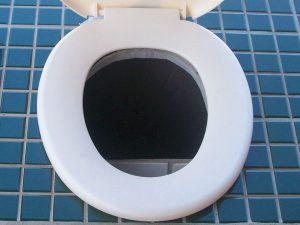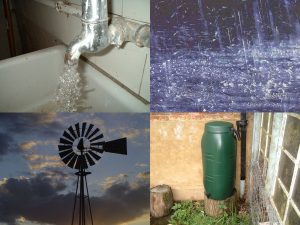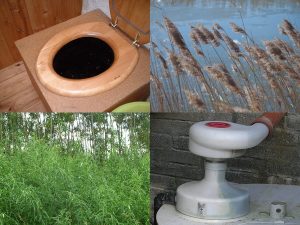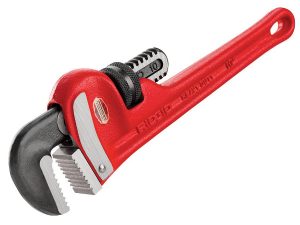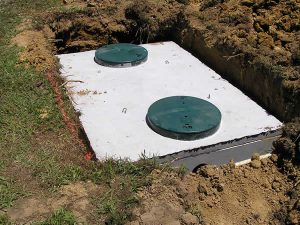Waterless urinals - introduction
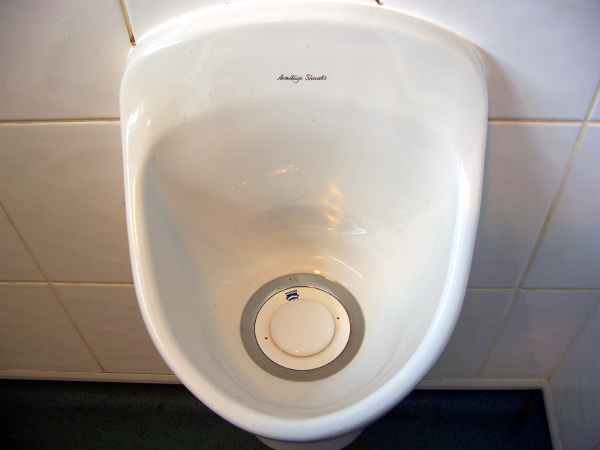
“The world is divided into two categories of people: those who piss in drinking water and those who don’t.” – (slightly adapted from) Joe Jenkins, the Humanure Handbook
Contents
What are waterless urinals?
They are urinals that use no water to flush away the urine. The usage of waterless urinals is becoming more common in public buildings such as offices, stadiums, bars, hotels etc. They can also be installed domestically, although this is less common.
To avoid using water in a urinal we must first consider what the water does. In a flush urinal, the U bend of continually-replenished water prevents smells from the sewer getting into the room. Water also cleans the fitting after use. So, these two objectives must be achieved by the waterless urinal technology.
Basic urinal
There are some off-grid applications where a basic urinal with no trap can be installed at a campsite or an allotment (see picture). This unit has a vent flue that gets the odours out of the room. Urine is taken away via a drain pipe.

Shed installation of the vented Biolan Urinal in Cornwall. No trap – the urine is just led away to the ground or to a straw-bale / sawdust pile to create compost. Good for alltoments / gardens. Pic: Toilet Revolution
Retrofit cartridges
Flush urinals can be retrofitted and made waterless by inserting a cartridge / some sort of one-way valve that allows urine to pass though and then closes to keep out smells. This type of product can be attractive in the short term as the installation does not require the urinals to be changed. Some have active enzymes that claim to remove smells from the urine, and some include a strong-smelling urinal cake (those little blue deodorising blocks) to mask any urine smell that lingers.
Complete waterless urinals
These are full waterless urinal fittings with a proprietary trap that has been designed for it. There are many brands of waterless urinal in this category, such as:
- Uridan
- Urimat
- Waterless
- Falcon
- Armitage Shanks
- Duravit
How the Uridan waterless toilet works (no moving parts).
Unisex models
There are also unisex waterless urinals available, that utilise the same kind of traps, but are used sitting down.
What are the benefits of waterless urinals?
Given that 90% of public toilet usage is for urination, and that many urinals could be getting no use, but still flushing every 15 minutes, there’s an opportunity to save large amounts of water. According to Wikipedia and manufacturers’ own estimates, a waterless urinal can save 100,000 litres per urinal per year.

Uridan and Falcon models.
Drinking water is an expensive thing to produce – there has to be lots of infrastructure in place to harvest, treat, and deliver it. It seems enormously wasteful to use it to flush away urine. There’s massive potential for waterless urinals, especially in drier countries. Germany is in the lead when it comes to installing waterless urinals – as is often the case with sustainable tech.
Urine can be used as a fertiliser (see below); it contains much more nitrogen by volume than faeces (around 90% of the nitrogen we excrete is in urine). Urine could replace chemical fertilizers in feeding the world’s population (although carbon-rich material would have to be added as well to provide structure and to aid decomposition), instead of being treated as a problem.
If looked after properly, waterless urinals actually smell less than flush urinals because in flush urinals, calcium in the water reacts with uric acid in the urine to produce more limescale than with water alone. The limescale then absorbs more urine, which encourages bacterial growth and can cause smells.
How the Zerodor trap works.
What can I do?
Waterless urinals work well with compost toilets, which don’t like too much urine, as it makes the pile too wet and introduces too much nitrogen.
Basic urinal
This is more polite than just doing it outside, if there are other people around (see picture of installation in an allotment shed). In most circumstances the urine is allowed to soak into the soil nearby, but it could also go onto a strawbale, or a pit with sawdust etc. to produce compost (see below).
Retrofit cartridges
The installation only requires the trap to be fitted below the urinal. But all pipes downstream should be either replaced of jetted to make sure that they’re clean. This will prevent problems with struvite – the mineral deposit that causes kidney stones and can cause blockages in pipes. Always refer to each manufacturers’ installation instructions.
How the ez-trap works.
It’s important to consider the ongoing costs of the cartridges, plus how long they last. Talk to the manufacturer / retailer. Also, you need to check your urinal(s) to make sure the shape sheds urine, as it was designed to be flushed, plus whether the cartridge creates pockets of standing urine as the two parts (urinal and cartridge) were not designed for each other.
Ask your plumbers’ merchant for a self-sealing waste valve. Some one-way valve / flap types of cartridge might be a bit too delicate for urine, and they might not kill the smell. Also, urine isn’t water. In high concentrations, it becomes sticky. If there are any moving parts, stickiness may seize them up. You also have to factor in hair, chewing gum, cigarette butts and other things that often end up in urinals, especially in public spaces, and make sure the urinal and trap will still work. This isn’t such a problem in a domestic installation, and may not be much of a problem if the toilet is outdoors. As a last resort, if it’s a retrofit, you can always turn the flush back on.
Another problem with retrofit is that you have to clean the fitting every day. Off-the-shelf waterless urinals have their own system for cleaning.

A Hepworth (HepVO) valve is a self-sealing waste valve – with an internal flap that lets liquid through and then closes. It’s the easiest way to convert a flush urinal to a waterless urinal (apart from no trap at all). It may be too flimsy for a heavily-used urinal.
Complete waterless urinals
Again, consider the ongoing costs of the trap replacement over time, how long each trap will last and how the trap will respond to items that often end up in urinals. There are some technologies that use floats and seals in their design that may have a problem with chewing gum, hair and other items which may cause the valve or seal to remain partially open causing odours.
In engineering, it’s preferable to remove moving parts from any design and Uridan deserve an honourable mention as they are unique in the market in that there are no moving parts in their trap and no plastic is used in trap replacement.
Installation of a waterless urinal from our compost toilets online course.
There are many different designs of the waterless trap, but all waterless urinals must be cleaned down each day to keep the fittings odour free. In most circumstances there is a proprietary liquid for waterless urinals that is compatible with the waterless trap / seal. The cost of this liquid needs to be factored into the running cost of the system.
Details of products can be found by searching online – you can see what might work for you and what won’t. Look for user reviews, and try to talk to the manufacturer / seller – ask exactly how it works, and think of things that might block the urinal. If you’ve had experience of any of the products, it would be great if you could leave feedback below.
How the Falcon model works.
Unisex models
This is a sit-down model, and it’s important to note that the urinal can’t accept toilet paper, so signage may need to be installed to ensure the unit is not clogged with paper. Unlike their male counterpart, which requires no adjustment in user behaviour, the unisex urinal does require some instruction – e.g. where to put the paper, plus that the unit can’t accept any solid waste so likely applications may be in offices and other locations where users can become used to the technology.

Unisex, sit-down waterless urinal.
Urine as fertiliser
There is some literature available covering urine as a fertiliser, as it contains N (Nitrogen), P (Phosporous), and K (Potassium) which boosts plant growth. But one needs to consider that if the urinal is used by anyone on medication, these chemicals will be introduced into the soil. In many circumstances the volume will be so tiny as to be insignificant but if someone was on chemotherapy for example, who used the urinal regularly, there could be downstream impact. Using urine as a fertiliser may be best done where you know who is using the urinal. Here are some guidelines for the safe use of urine.
Advice on urine as a fertiliser.
In the right circumstances, you can pee on a straw-bale to eventually produce compost. Urine contains lots of nitrogen, straw contains lots of carbon, and so this is a perfect recipe for producing good compost. You can put the bale in any out-of-the-way place. It won’t smell because the bacteria will have a ‘balanced diet’ of carbon and nitrogen, and so won’t have to give off ammonia (a way of removing excess nitrogen). You could also collect urine in a container with a funnel, and tip it onto your compost heap when it’s full. This will benefit the heap, especially if it has a lot of carbon-rich material like dry leaves, twigs, straw or hay.
Specialist(s)
Thanks to Patrick Boylan of Toilet Revolution for information.
The specialist(s) below will respond to queries on this topic. Please comment in the box at the bottom of the page.

Patrick Boylan has had a long-term interest in the environment. A graduate of the Trinity College Dublin Botany Department in 1998, he founded Toilet Revolution in 2012. Patrick has researched manufacturers the world over, and Toilet Revolution have hundreds of compost toilet and waterless urinal installations around the UK and Ireland.

